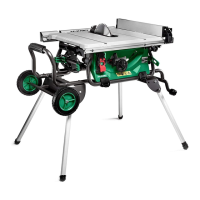6
The use of improper accessories may risk injury.
• NEVER STAND ON TOOL. Serious injury could occur if the tool is tipped or if the cutting tool is
unintentionally contacted. Do not use it as a stepping stool.
• CHECK DAMAGED PARTS. Before further use of the tool, a guard or other part that is damaged
should be carefully checked to determine that it will operate properly and perform its intended function.
Check for alignment of moving parts, binding of moving parts, breakage of parts, mounting and any other
conditions that may affect its operation. A guard or other part that is damaged must be properly repaired
or replaced by an authorized service center to avoid risk of personal injury.
• USE THE RIGHT DIRECTION OF FEED. Feed workpiece into a blade or cutter against the direction
of rotation of blade or cutter only. Feeding the workpiece in the same direction that the saw blade is
rotating above the table may result in the workpiece, and your hand, being pulled into the saw blade.
• NEVER LEAVE TOOL RUNNING UNATTENDED. Turn the power off. Don’t leave tool until it comes
to a complete stop. An unattended running saw is an uncontrolled hazard.
• PROTECT YOUR LUNGS. Wear a face or dust mask if the cutting operation is dusty.
• PROTECT YOUR HEARING. Wear ear plugs or muffs during extended periods of operation.
• DO NOT ABUSE CORD. Never yank cord to disconnect from receptacle. Keep cord away from heat,
oil, and sharp edges.
• WHEN OPERATING A POWER TOOL OUTSIDE, USE AN OUTDOOR EXTENSION CORD
MARKED “W-A” OR “W”. These cords are rated for outdoor use and reduce the risk of electric shock.
• ALWAYS KEEP THE BLADE GUARD AND SPREADER (RIVING KNIFE) IN PLACE and in
working order for all through cut operations. Reinstall the blade guard immediately after finishing any
non-through cut operations which require removal of the blade guard.
• ADJUST THE RIVING KNIFE AS DESCRIBED IN THIS INSTRUCTION MANUAL. Incorrect
spacing, positioning and alignment can make the riving knife ineffective in reducing the likelihood of
kickback.
• FOR THE RIVING KNIFE AND ANTI-KICKBACK PAWLS TO WORK, THEY MUST BE
ENGAGED IN THE WORKPIECE. The riving knife and anti-kickback pawls are ineffective when
cutting workpieces that are too short to be engaged with the riving knife and anti-kickback pawls. Under
these conditions a kickback cannot be prevented by the riving knife and anti-kickback pawls.
• USE THE APPROPRIATE SAW BLADE FOR THE RIVING KNIFE. For the riving knife to function
properly, the saw blade diameter must match the appropriate riving knife and the body of the saw blade
must be thinner than the thickness of the riving knife and the cutting width of the saw blade must be wider
than the thickness of the riving knife.
• KEEP BLADES CLEAN, SHARP, AND WITH SUFFICIENT SET. Sharp blades minimize stalling
and kickback.
• KEEP HANDS AWAY FROM CUTTING AREA. Keep hands away from blades. Do not reach
underneath work or around or over the blade while blade is rotating. Do not attempt to remove
cut material when blade is moving. The material may become trapped between the fence or inside the
saw blade guard and the saw blade pulling your fingers into the saw blade. Turn the saw off and wait
until the saw blade stops before removing material.
• BLADE COASTS AFTER BEING TURNED OFF.
• NEVER USE IN AN EXPLOSIVE ATMOSPHERE.
Normal sparking of the motor could ignite fumes.
• INSPECT TOOL CORDS PERIODICALLY. If damaged, have repaired by a qualified service technician
at an authorized service facility. The conductor with insulation having an outer surface that is green with
or without yellow stripes is the equipment-grounding conductor. If repair or replacement of the electric
cord or plug is necessary, do not connect the equipment-grounding conductor to a live terminal. Repair
or replace a damaged or worn cord immediately. Stay constantly aware of cord location and keep it well
away from the rotating blade.
• INSPECT EXTENSION CORDS PERIODICALLY and replace if damaged.
• GROUND ALL TOOLS. If tool is equipped with three-prong plug, it should be plugged into a three-hole
electrical receptacle.
• CHECK WITH A QUALIFIED ELECTRICIAN or service personnel, if the grounding instructions are
not completely understood, or if in doubt as to whether the tool is properly grounded.
• USE ONLY CORRECT ELECTRICAL DEVICES: 3-wire extension cords that have 3-prong grounding
plugs and 3-hole receptacles that accept the tool's plug.
English

